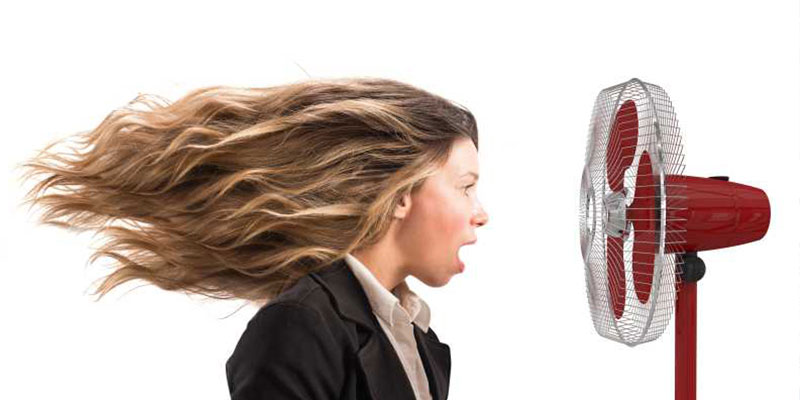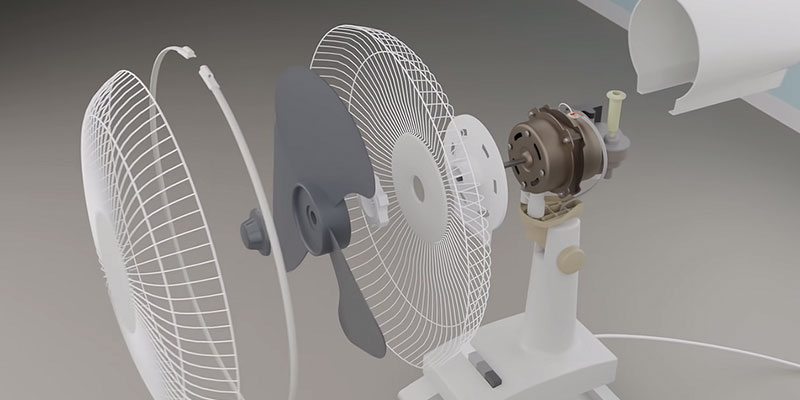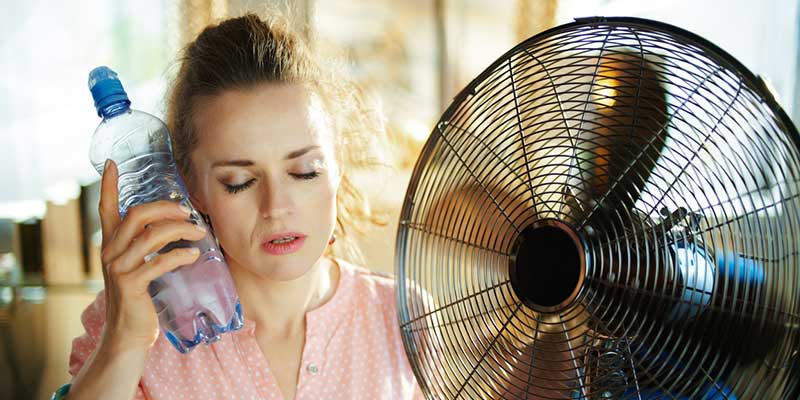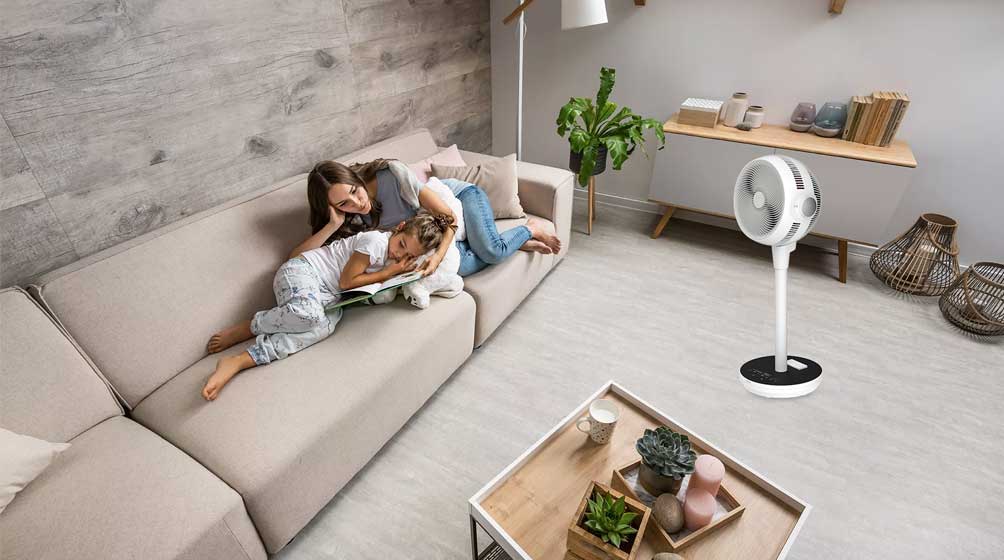Fan Types, Best Fan Manufacturers

LlianChuang

8976 views

February 18, 2025
Fans have always been a common cooling tool in summer families. From the invention of the first fan to the present 2025, many styles and types have been updated and iterated. Some fans with novel styles and full functions are more and more popular in the market.

The origin of fans
The origin of fans can be traced back to ancient times, with the earliest forms being manual fans. In India around 500 BC, people used hand-held fans, probably made of bamboo strips or other plant fibers, to fan the air and cool it down. Manual rotating fans appeared in China during the Han Dynasty, and the seven-wheeled fan invented by Ding Yu, with a diameter of 3 meters, was turned by manual operation and can be regarded as the prototype of modern fans.
In the course of technological progress, in 1830, James Byron invented the first mechanical fan, a device fixed on the ceiling and driven by a clockwork, which marked the birth of the mechanical fan although it was inconvenient to use. Then, after continuous improvement, in 1880, American Shule installed the blades directly on the motor, creating the world's first electric fan, which completely changed the way people enjoy cool in summer.

How the fan works
The fan works mainly based on the conversion of electrical energy into mechanical energy, which in turn generates airflow. Here's how it basically works:
1. Power input
After the fan is energized, current passes through the motor, providing it with power.
2 Electromagnetic action
The coil in the motor generates a magnetic field under the action of current, which interacts with the permanent magnet or electromagnet to push the rotor to rotate.
3 Turn mechanically
The rotor spins the fan blades, which are designed at a specific Angle to push the air.
4. Air flow is generated
The rotating blade pushes the air, forming a airflow, the air pressure in front of the blade decreases, the air pressure behind it increases, and the air flows from the high pressure area to the low pressure area, creating wind.
5. Control wind speed
Control the wind speed by adjusting the voltage or current and changing the motor speed. Some fans also support functions such as timing and shaking head.

Different types of fans
Fans can be divided into many types according to their working principles, functions, and application scenarios. Here are several common fan types and their characteristics:
1. Electric fan
Definition: The most traditional type of fan, which uses an electric motor to drive the blades to rotate, creating airflow.
Features:
Type: including floor fans, table fans, wall fans, etc.
Volume of air: Usually large volume of air, suitable for rapid cooling in large Spaces.
Noise: Noise levels vary depending on the type and quality of the motor, AC motors are noisy and DC variable frequency motors are quieter.
Control mode: It can be manually adjusted, remote control or intelligent control.
2. Bladeless fan
Definition: Uses aerodynamic principles to draw air through the base and blow it out through the edge gaps.
Features:
Safety: no exposed fan leaves, reduce security risks.
Easy to clean: no sanitary dead corners, easy to clean.
Wind sense: The wind blowing out is softer, close to the natural wind.
Multi-function: part of the bladeless fan integrates air purification, humidification and other functions.
Price: Usually the price is higher because of its technical complexity.
3. Air circulation fan
Definition: The use of vortex air circulation technology, through the blower to enhance air flow, long distance air supply, wide coverage.
Features:
Wind concentration: the wind blowing out is more concentrated, and the air supply distance can reach more than 20 meters.
Air circulation: can quickly uniform indoor temperature and humidity, suitable for large space.
Shaking head function: Support shaking head up and down, expand the air supply range.
Noise: relatively low, suitable for long time use.

4 Tower fans
Definition: A tubular drum design with soft wind, suitable for sleeping.
Features:
Appearance: Slim and takes up little space.
Wind: The wind is weak, suitable for users who prefer a soft wind feel.
Noise: Usually less noisy and suitable for night use.
Cleaning: The internal fan leaves are more difficult to clean.
5. Air conditioning fan (cold fan)
Definition: A combination of an electric fan and a water-cooling system that reduces the temperature of the outgoing air through a curtain of water or ice water.
Features:
Cooling effect: can blow out low temperature wind, suitable for hot and dry weather.
Air purification: filtered through the water curtain, with a certain air purification function.
Energy consumption: Compared with the electric fan, the energy consumption is low, but the water source needs to be added.
Application scenario: indoor and outdoor can be used, especially suitable for the environment without air conditioning.

6. Cooling fan
Definition: Used for cooling electronic devices, such as computer cpus, graphics cards, etc.
Features:
Control mode: usually adopts PWM (pulse width modulation) control, and automatically adjusts the speed according to the temperature.
Material: high temperature resistant material is used to ensure long-term stable operation.
Size: customized according to equipment needs, ranging from a few centimeters to tens of centimeters.
Noise: High performance cooling fans may be accompanied by higher noise, but modern design has been greatly reduced.
7. Smart fans
Definition: Integrated intelligent control technology, can automatically adjust the wind speed and mode according to the environmental temperature, human body temperature and other parameters.
Features:
Environmental awareness: Monitoring indoor temperature and human activity through sensors.
Remote control: It can be controlled by mobile App or voice assistant.
Energy saving: Avoid unnecessary energy consumption through intelligent adjustment.
Comfort: Provide personalized wind sense to meet the preferences of different users.
8. Window frame type bladeless fan
Definition: A specially designed bladeless fan that can be mounted on a window frame to regulate indoor air flow through an intelligent control system.
Features:
Intelligent: real-time monitoring of the environment and human data, intelligent regulation of air flow.
Easy installation: no extra space required, suitable for various window sizes.
Energy saving: Adjust the air volume according to the actual demand to reduce energy waste.

9. Portable fans
Definition: Small, lightweight, easy to carry, and usually battery powered.
Features:
Portability: Suitable for outdoor activities such as travel, picnics, etc.
Battery life: Depending on battery capacity and usage mode, battery life varies from a few hours to dozens of hours.
Noise: Usually low noise, suitable for quiet environment use.
Design: simple fashion design, easy to integrate into a variety of scenes.
10. Industrial fan
Definition: Used in large industrial locations, such as factories, warehouses, etc., to provide strong ventilation and cooling effects.
Features:
Huge air volume: it can cover a large area of space to ensure air circulation.
Durability: high strength material, suitable for harsh working environment.
Noise control: Industrial grade noise reduction design to reduce the impact on employees.
Intelligent control: Some models support remote monitoring and automated management.
11. Wall-mounted fan
Definition: A fan that can be hung from a wall and used to save floor space.
Features:
Space saving: does not take up ground space, suitable for limited space environment.
Wind distribution: Usually the wind distribution is more uniform, suitable for the overall cooling of the room.
Easy installation: it can be installed by hook or special bracket.
Design style: A variety of styles to choose from to meet the needs of different decoration styles.

12. Table fan
Definition: A fan that is placed on a desktop for use and is small enough to move easily.
Features:
Portability: It can be moved at any time to adapt to different work or life scenarios.
Wind regulation: most of them are equipped with multi-speed wind regulation to meet different needs.
Simple design: the use of simple design, suitable for modern home style.
Silent design: Some high-end models use a silent motor, suitable for office or bedroom use.
13. Columnar fans
Definition: Columnar in appearance, usually used standing, strong wind.
Features:
Strong wind: can provide strong wind, suitable for fast cooling in large space.
Good stability: low center of gravity, not easy to lodging.
Multi-gear adjustment: Usually equipped with multi-gear wind speed adjustment to adapt to different needs.
Stylish design: Some models feature a stylish design that is suitable for modern home decor.
14. Ceiling fans
Definition: Mounted on the ceiling and cantilevered to provide extensive wind coverage.
Features:
Wide wind: can cover the whole room, suitable for large space use.
Space saving: does not take up ground space, suitable for a variety of layouts.
Multi-gear adjustment: Usually equipped with multi-gear wind speed adjustment to adapt to different needs.
Design classic: The use of classic design, suitable for a variety of decoration styles.
15. USB fan
Definition: Powered by a USB interface, it is small and easy to carry.
Features:
Portability: can be carried around, suitable for office, car and other scenes.
Low power consumption: It is usually designed with low power consumption and suitable for long time use.
Quiet design: Some high-end models feature quiet motors that are suitable for office or library use.
A variety of designs: Available in a variety of styles and colors to suit different preferences.

The best fan manufacturers
From the global market sales of the fan industry in 2024, it can be seen that good fan manufacturers are very sought after by suppliers. Take the Chinese fan manufacturer Lianchuang as an example, the sales volume of fans in 2024 has exceeded 50 million pieces, which is enough to show the strength of Lianchuang in the fan industry. In China's fan manufacturers are also one of the best manufacturing factories.
Share:









